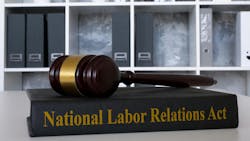The power of the National Labor Relations Board (NLRB) to control relations between employers and labor unions may be severely reduced because of a recent federal appeals court decision that held the board as it is currently organized is in violation of the U.S. Constitution.
In existence since it was created by Congress in 1935 when it passed the National Labor Relations Act (NLRA), the extent of the agency’s legal powers was brought to a head during President Trump’s second administration that began as soon as he was inaugurated earlier this year. However, the fact is that the unraveling process began as early as 2021 during the first half hour of the previous administration, when within 30 minutes of being sworn in, President Biden fired the then-NLRB General Counsel Peter Robb, who had been nominated by Trump and was then in the midst of serving what had been designated by Congress to be a five-year term.
Robb’s firing came as a shock because previously board counsels had been allowed to complete their terms when a new President came in. That had included the previous Obama-appointed counsel, who President Trump made no attempt to remove during his first presidency, at that time allowing the counsel to serve out the remainder of his term.
(The NLRB is the only federal agency where the general counsel is nominated and then confirmed by the Senate to serve a term of five years, just like the five board members. That is largely because the NLRB counsel plays a much bigger role in setting policy than do the general counsels of other agencies.)
After Biden fired the general counsel in 2021, Democrats crowed mockingly when the courts upheld Biden’s action, creating consternation among Republicans. But now it turns out that Biden’s supporters should have been more wary about what could follow after they got what they had wished for.
Immediately after Trump’s second term began earlier this year, Republicans did not hesitate to push his ability to fire members of boards and commissions even further, arguing that the President—under the exclusive administrative powers granted to him by the Constitution—also can remove members of NLRB and the other independent agencies that have been created by Congress over the years.
So far, the Supreme Court has shown itself to be largely in agreement with this viewpoint. In May, the High Court granted Trump’s similar request to fire members of the NLRB and the Merit Systems Protection Board (MSPB). But the recent Fifth Circuit decision even goes a full step further by determining that the board’s very existence may be in violation of the plain language of Article II of the Constitution, which succinctly defines the President’s administrative powers, when Congress attempted to remove their operations from the direct supervision of the President.
This ultimate assertion of the President’s power to shut down an agency’s operations has not yet been fully litigated up to what is expected to be the final word on this matter—a decision by the Supreme Court—but that eventuality could be not too far off with this case and others wending their way in that direction.
Constitution’s Plain Language
Perhaps we should not be too surprised that the Fifth Circuit U.S. Court of Appeals decision asserting the NLRB is unconstitutional involves SpaceX, the company owned by Trump’s recent political ally Elon Musk, but then again, the Tesla founder also is famous for his contrarian bent.
Perhaps attempting to blunt accusations that they were bending their will to that of Musk, the court yoked together two other cases that along with the SpaceX complaint ended up deciding the constitutionality of the NLRB’s members’ and administrative law judges’ long-asserted power to decide labor law complaints involving employers and union activities any way they wish without being concerned about possibly being fired by a President who disagrees.
In the opinion of the Trump Administration and its supporters, the Constitution organized the three branches of the federal government in such a way that grants the President the sole authority over the administrative branch, thus making it unlawful for Congress to create administrative agencies intended to lie outside of his managerial control.
While the NLRA established workers’ right to organize into unions and to collectively negotiate the terms of their employment, there has existed a fundamental split in attitudes regarding the board’s responsibility for enforcing it. Union advocates, generally Democrats, have seen the NLRB’s mission as advancing the cause of unionism in any way it can under the law. Others, primarily Republicans, view the board as more of an impartial umpire, charged with making sure both unions and employers hew to the law.
At present, the Fifth Circuit decision only directly impacts pending litigation involving board actions that it has taken against those employers whose businesses fall within the court’s geographic jurisdiction: the states of Louisiana, Mississippi and Texas.
In another development, on May 22, 2025, the U.S. Supreme Court issued a decision granting President Trump’s emergency application to stay the D.C. Circuit Court’s orders that had reinstated NLRB member Gwynne A. Wilcox and MSPB member Cathy A. Harris, whom Trump had removed from their posts. The stay will remain in effect while the D.C. Circuit Court continues to review the lawfulness of their removals, and in the meantime, they can no longer function in their previous roles.
Meanwhile, with Wilcox’s absence and two Trump board nominees awaiting Senate confirmation, the normally five-member NLRB currently is down to two sitting members, meaning that it lacks a quorum and as a result cannot act to make new policy.
At this point, legal observers believe that if the Supreme Court eventually upholds the Fifth Circuit decision on the NLRB’s constitutionality, the NLRA will remain in effect, and the board could still be in a position to continue enforcing it. A bigger possibility is that the President will end up with the unfettered ability to remove its board members and other employees, including administrative law judges who are responsible for deciding federal labor law civil cases, if it turns out that he disagrees with the policy direction they are taking.
“This is not a ‘shut down the NLRB’ moment—at least not yet,” in the view of Tashayla “Shay” Billington, an attorney with the law firm of CDF Labor Law LLP. “But it is a flashing neon sign that the board’s power is being tested like never before.”
Among those who believe it is unlikely that the Supreme Court would upend the NLRA, even if it finds the President can fire the members and staff of the board, are attorneys Brian Hayes, Thomas Stanek and Zachary Zagger with the Ogletree Deakins law firm.
“In essence, it would require a finding that in the absence of the statutory removal protections, Congress never would have passed the NLRA in the first place,” they point out. “Unlikely as that might be, the unfolding constitutional debate demands attention.”
But Holland & Knight attorneys Andrea James, Hannah Fitzgerald and Carson Blakely float another possibility. “If the structural defects are not remedied, the NLRB may be unable to proceed with enforcement actions, potentially invalidating or indefinitely delaying a wide range of cases beyond the underlying cases where injunctions have issued. Though this outcome is less likely, it remains a possibility and could have far-reaching effects on labor law enforcement mechanisms.”
About the Author

David Sparkman
founding editor
David Sparkman is founding editor of ACWI Advance (www.acwi.org), the newsletter of the American Chain of Warehouses Inc. He also heads David Sparkman Consulting, a Washington D.C. area public relations and communications firm. Prior to these he was director of industry relations for the International Warehouse Logistics Association. Sparkman has also been a freelance writer, specializing in logistics and freight transportation. He has served as vice president of communications for the American Moving and Storage Association, director of communications for the National Private Truck Council, and for two decades with American Trucking Associations on its weekly newspaper, Transport Topics.
